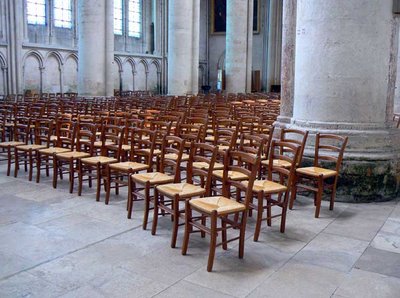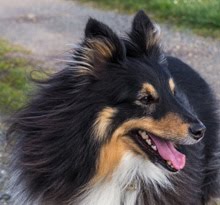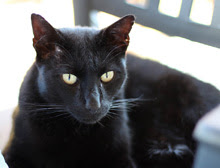Still in Normandy, still at the cathedral in Sées (pronounced "say"). The building is voluminous and filled with evidence of human activity, but very few humans on this Monday.
Friday, June 30, 2006
Thursday, June 29, 2006
It's Not My Vault !
These are some views of the spectacular ceiling of the 14th century Norman Gothic cathedral in Sées, in southern Normandy.

 Great columns support the stonework, which is well lit by the vast stained glass windows all around.
Great columns support the stonework, which is well lit by the vast stained glass windows all around.
The cathedral was our first stop on a trip to Normandy and, more specifically, the Mont Saint Michel, last week. Look for more in upcoming posts and at Ken's site.

 Great columns support the stonework, which is well lit by the vast stained glass windows all around.
Great columns support the stonework, which is well lit by the vast stained glass windows all around.The cathedral was our first stop on a trip to Normandy and, more specifically, the Mont Saint Michel, last week. Look for more in upcoming posts and at Ken's site.
Labels:
cathedrals and churches,
normandy
Tuesday, June 27, 2006
Un Jour, Une Tour [18]
 Number 18 in the series! These two towers are photo holders. The one holding the card with a picture of the E.T. (not my photo) is magnetic; there is a metal stand behind the card and the little tower is a magnet that holds the card on the metal plate.
Number 18 in the series! These two towers are photo holders. The one holding the card with a picture of the E.T. (not my photo) is magnetic; there is a metal stand behind the card and the little tower is a magnet that holds the card on the metal plate.The other wire tower has an alligator clip on top that can hold a postcard or other small items.
Labels:
eiffel tower
Monday, June 26, 2006
Sunday, June 25, 2006
La Vie et la Mort
The black redstarts have not been hanging around their nest lately. Here's why:
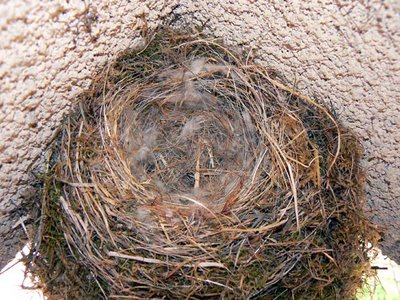 The chicks are gone! I assume that something got them during the night; they certainly were nowhere near fledging, only having hatched on Tuesday (click here to see). I haven't researched yet to see what could have been the culprit - I suspect maybe an owl or some other winged creature, but there are other possibilities. At any rate, the chicks are gone and so are the parents.
The chicks are gone! I assume that something got them during the night; they certainly were nowhere near fledging, only having hatched on Tuesday (click here to see). I haven't researched yet to see what could have been the culprit - I suspect maybe an owl or some other winged creature, but there are other possibilities. At any rate, the chicks are gone and so are the parents.
I'll leave the nest up for a little while, but I'd be surprised if the redstart comes back to lay more eggs.
**UPDATE**
I've done some research, and it seems that accipiters are common predators of small birds and chicks. According to Wikipedia, accipiters are known commonly as goshawks or sparrowhawks. Other candidates include a mouse or a rat, or even one of the neighborhood cats. If any birders are reading this (and you know who you are), please tell me what you think.
I looked up goshawks (accipiter gentilis - autour des palombes in French) and sparrowhawks (accipiter nisus - épervier d'europe in French) in the bird books. They do live around here and they do prey on small birds captured live.
Also, the bird book says that the black redstart typically nests twice a year: once in April/May, then again in June/July. Sometimes they will nest a third time in July. What I don't know is if they'll return to the old nest or build a new one.
 The chicks are gone! I assume that something got them during the night; they certainly were nowhere near fledging, only having hatched on Tuesday (click here to see). I haven't researched yet to see what could have been the culprit - I suspect maybe an owl or some other winged creature, but there are other possibilities. At any rate, the chicks are gone and so are the parents.
The chicks are gone! I assume that something got them during the night; they certainly were nowhere near fledging, only having hatched on Tuesday (click here to see). I haven't researched yet to see what could have been the culprit - I suspect maybe an owl or some other winged creature, but there are other possibilities. At any rate, the chicks are gone and so are the parents.I'll leave the nest up for a little while, but I'd be surprised if the redstart comes back to lay more eggs.
**UPDATE**
I've done some research, and it seems that accipiters are common predators of small birds and chicks. According to Wikipedia, accipiters are known commonly as goshawks or sparrowhawks. Other candidates include a mouse or a rat, or even one of the neighborhood cats. If any birders are reading this (and you know who you are), please tell me what you think.
I looked up goshawks (accipiter gentilis - autour des palombes in French) and sparrowhawks (accipiter nisus - épervier d'europe in French) in the bird books. They do live around here and they do prey on small birds captured live.
Also, the bird book says that the black redstart typically nests twice a year: once in April/May, then again in June/July. Sometimes they will nest a third time in July. What I don't know is if they'll return to the old nest or build a new one.
Saturday, June 24, 2006
Friday, June 23, 2006
Un Jour, Une Tour [17]
The seventeenth post in this Eiffel Tower series is here, right now, just for you!
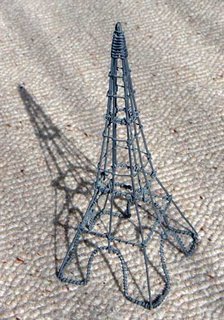 I have completely forgotten where this small wire tower came from. It's about 18 cm (7 inches) tall, and for some reason I think it was intended as a holiday tree ornament, but I'm not certain.
I have completely forgotten where this small wire tower came from. It's about 18 cm (7 inches) tall, and for some reason I think it was intended as a holiday tree ornament, but I'm not certain.
Oh well, it casts a nice shadow!
 I have completely forgotten where this small wire tower came from. It's about 18 cm (7 inches) tall, and for some reason I think it was intended as a holiday tree ornament, but I'm not certain.
I have completely forgotten where this small wire tower came from. It's about 18 cm (7 inches) tall, and for some reason I think it was intended as a holiday tree ornament, but I'm not certain.Oh well, it casts a nice shadow!
Labels:
eiffel tower
Thursday, June 22, 2006
The Chicks, Part One
The chicks hatched in the past day or so (click here to see the mother sitting in the nest, and here for a photo of the eggs; use your "back" button to return to this page).
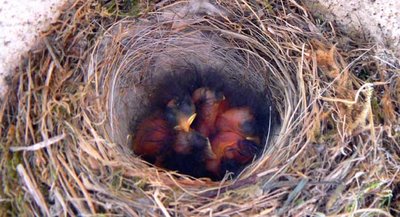 When I put the camera above the nest, none of the chicks opened its beak for food, but I assume that it won't take very long before any movement above the nest illicits a lot of begging. We should start hearing them "cheep" soon; I'll take another picture at that stage.
When I put the camera above the nest, none of the chicks opened its beak for food, but I assume that it won't take very long before any movement above the nest illicits a lot of begging. We should start hearing them "cheep" soon; I'll take another picture at that stage.
There were five eggs. I can't tell from this picture how many chicks there are.
 When I put the camera above the nest, none of the chicks opened its beak for food, but I assume that it won't take very long before any movement above the nest illicits a lot of begging. We should start hearing them "cheep" soon; I'll take another picture at that stage.
When I put the camera above the nest, none of the chicks opened its beak for food, but I assume that it won't take very long before any movement above the nest illicits a lot of begging. We should start hearing them "cheep" soon; I'll take another picture at that stage.There were five eggs. I can't tell from this picture how many chicks there are.
Wednesday, June 21, 2006
Calling Cliff Clavin
Remember the Cliff Clavin character from the American TV show, "Cheers?" Well, he was known to bring a potato or a turnip into the bar claiming it was the spitting image of Richard Nixon or June Lockhart. Here's my Cliff Clavin moment:
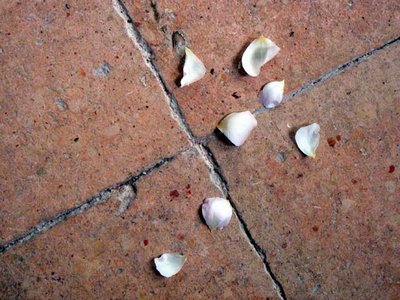 These flower petals fell on the floor of the church in Palluau-sur-Indre in the shape of the cross. Alert the media! It's a miracle - even though it's not a danish in the image of the virgin Mary. Now, how can I cash in?
These flower petals fell on the floor of the church in Palluau-sur-Indre in the shape of the cross. Alert the media! It's a miracle - even though it's not a danish in the image of the virgin Mary. Now, how can I cash in?
 These flower petals fell on the floor of the church in Palluau-sur-Indre in the shape of the cross. Alert the media! It's a miracle - even though it's not a danish in the image of the virgin Mary. Now, how can I cash in?
These flower petals fell on the floor of the church in Palluau-sur-Indre in the shape of the cross. Alert the media! It's a miracle - even though it's not a danish in the image of the virgin Mary. Now, how can I cash in?
Labels:
cathedrals and churches,
whatnot
Monday, June 19, 2006
Bleu
The Château de Chenonceau spans the Cher river and is lit up at night, or on special nights, by colored flood lights attached to walls in strategic locations. These are some of the blue ones.
 There are three colors: blue, white, and red (like the French flag). I need to get over there one night to see what it looks like all lit up. If only I could stay up that late...
There are three colors: blue, white, and red (like the French flag). I need to get over there one night to see what it looks like all lit up. If only I could stay up that late...
 There are three colors: blue, white, and red (like the French flag). I need to get over there one night to see what it looks like all lit up. If only I could stay up that late...
There are three colors: blue, white, and red (like the French flag). I need to get over there one night to see what it looks like all lit up. If only I could stay up that late...
Labels:
châteaux,
cher valley
Sunday, June 18, 2006
Un Jour, Une Tour [16]
Here is number 16 in the Eiffel Tower series:
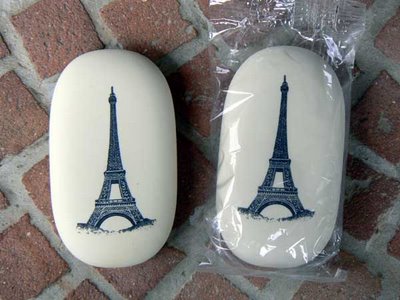 These are gummy erasers with the image of the tower somehow stamped on. Each was a gift, each from someone different. I took one out of its wrapper to show it better. As you can see, they haven't been used. They've become part of the permanent collection.
These are gummy erasers with the image of the tower somehow stamped on. Each was a gift, each from someone different. I took one out of its wrapper to show it better. As you can see, they haven't been used. They've become part of the permanent collection.
 These are gummy erasers with the image of the tower somehow stamped on. Each was a gift, each from someone different. I took one out of its wrapper to show it better. As you can see, they haven't been used. They've become part of the permanent collection.
These are gummy erasers with the image of the tower somehow stamped on. Each was a gift, each from someone different. I took one out of its wrapper to show it better. As you can see, they haven't been used. They've become part of the permanent collection.
Labels:
eiffel tower
Saturday, June 17, 2006
Le Potager
Jardin potager is French for kitchen garden, or what we usually call a vegetable garden - potager is an adjective that describes plants (but not grains) that are used by humans for food. Here in our yard, we dug up 4 square plots for our first jardin potager two years ago. Each year they get tilled before we plant seeds or plants that we've bought at the market.

This year we have 16 tomato plants (of differing varieties), 12 peppers, 8 eggplant, a row of mustard greens, two rows of runner beans (thanks to British pals Janet & David for the seeds), 2 hills of zucchini, 2 hills of yellow squash, and 2 hills of cucumbers. The first year we planted nasturtiums among the tomatoes and they've been re-seeding themselves and are now regular volunteers in three of the four plots. The yard is fenced, so we don't need to worry about hungry deer visiting us during the night.
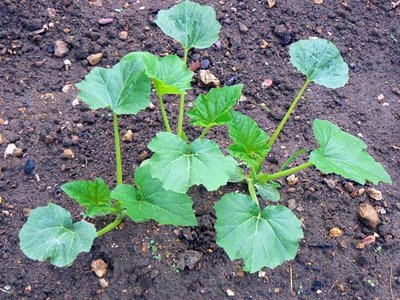 All six of the the yellow squash seeds came up in this hill; three have already been pulled as part of the thinning process.
All six of the the yellow squash seeds came up in this hill; three have already been pulled as part of the thinning process.
 Nasturtiums come up from seed each year in between the tomatoes and other vegetables; they'll be producing edible flowers soon.
Nasturtiums come up from seed each year in between the tomatoes and other vegetables; they'll be producing edible flowers soon.
One of the four plots is becoming a "permanent" herb garden (below). I've trained a rosemary plant into a basic shape as the centerpiece, and have perennial herbs like sage, thyme, and chives planted around the plot. There's also a row of rhubarb that I moved and divided from another location this spring - next year it should be ready for harvesting! There are lupens, lavender, and other perennial flowers here and there. Of course, the plot also includes room for annuals like basil, coriander, chervil, and parsely.

This year we have 16 tomato plants (of differing varieties), 12 peppers, 8 eggplant, a row of mustard greens, two rows of runner beans (thanks to British pals Janet & David for the seeds), 2 hills of zucchini, 2 hills of yellow squash, and 2 hills of cucumbers. The first year we planted nasturtiums among the tomatoes and they've been re-seeding themselves and are now regular volunteers in three of the four plots. The yard is fenced, so we don't need to worry about hungry deer visiting us during the night.
 All six of the the yellow squash seeds came up in this hill; three have already been pulled as part of the thinning process.
All six of the the yellow squash seeds came up in this hill; three have already been pulled as part of the thinning process. Nasturtiums come up from seed each year in between the tomatoes and other vegetables; they'll be producing edible flowers soon.
Nasturtiums come up from seed each year in between the tomatoes and other vegetables; they'll be producing edible flowers soon.One of the four plots is becoming a "permanent" herb garden (below). I've trained a rosemary plant into a basic shape as the centerpiece, and have perennial herbs like sage, thyme, and chives planted around the plot. There's also a row of rhubarb that I moved and divided from another location this spring - next year it should be ready for harvesting! There are lupens, lavender, and other perennial flowers here and there. Of course, the plot also includes room for annuals like basil, coriander, chervil, and parsely.
Labels:
garden flowers plants,
our house
Friday, June 16, 2006
The Eggs
I've been waiting patiently (with my handy ladder nearby) for the mother redstart to leave the nest in the evening so that I could climb up and look at the eggs. Here they are:
 There are five eggs, as you can see, which conforms neatly with the description in the bird book. It won't be long before we have some chicks, I'm sure. I'll keep you posted!
There are five eggs, as you can see, which conforms neatly with the description in the bird book. It won't be long before we have some chicks, I'm sure. I'll keep you posted!
It's weird, but when the bird was trying to build the nest, I was totally against it being there. All I could think of was bird poop on the deck. Now that she actually got it built and there are eggs inside, I can't think of why I wanted it gone. Go figure.
 There are five eggs, as you can see, which conforms neatly with the description in the bird book. It won't be long before we have some chicks, I'm sure. I'll keep you posted!
There are five eggs, as you can see, which conforms neatly with the description in the bird book. It won't be long before we have some chicks, I'm sure. I'll keep you posted!It's weird, but when the bird was trying to build the nest, I was totally against it being there. All I could think of was bird poop on the deck. Now that she actually got it built and there are eggs inside, I can't think of why I wanted it gone. Go figure.
Thursday, June 15, 2006
Bird on a Column
A couple of weeks ago we noticed a bird trying to build a nest on the column of our deck. The wind that day kept knocking the nesting material onto the deck, thwarting the bird's efforts. When we got back from our Paris trip we found this:

She was apparently successful in the end. She is a rougequeue noir in French (Phoenicurus ochruros), or a black redstart in English. The book says they frequently nest on buildings which simulate their natural rock-face habitat. I haven't really noticed a male around, just her.
We keep an eye on her, and when she's not out feeding, she sits on what we assume are her newly laid eggs, keeping a watchful eye on us. One day we'll have peeping chicks up there, I'm sure.

She was apparently successful in the end. She is a rougequeue noir in French (Phoenicurus ochruros), or a black redstart in English. The book says they frequently nest on buildings which simulate their natural rock-face habitat. I haven't really noticed a male around, just her.
We keep an eye on her, and when she's not out feeding, she sits on what we assume are her newly laid eggs, keeping a watchful eye on us. One day we'll have peeping chicks up there, I'm sure.
Wednesday, June 14, 2006
Un Jour, Une Tour [15]
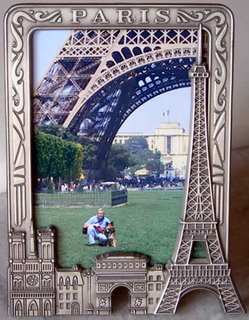 I picked up this way-too-touristy picture frame at the Charles deGaulle Airport one year a while back. Three years ago, Ken, Collette and I arrived in France to begin our Loire Valley life, and we went to Paris soon after so that Collette could romp on the Champ de Mars. Not that she could romp much on-leash, but you get the idea.
I picked up this way-too-touristy picture frame at the Charles deGaulle Airport one year a while back. Three years ago, Ken, Collette and I arrived in France to begin our Loire Valley life, and we went to Paris soon after so that Collette could romp on the Champ de Mars. Not that she could romp much on-leash, but you get the idea.I recently put this picture of Ken and the dog in the frame as a memory of that day.
I like the tower-within-a-tower effect.
Labels:
eiffel tower
Tuesday, June 13, 2006
101 California
 With a nod to Manuel Guerzoni at SF Daily Photo, this is a shot I took in SF in September 2005. I hope Manu enjoys my take on his city. It's 101 California Street, a building designed by Philip Johnson, taken from one of the skywalks at the Embarcadero Center.
With a nod to Manuel Guerzoni at SF Daily Photo, this is a shot I took in SF in September 2005. I hope Manu enjoys my take on his city. It's 101 California Street, a building designed by Philip Johnson, taken from one of the skywalks at the Embarcadero Center.
Labels:
usa
Monday, June 12, 2006
Dinner in the Yard
With our current stretch of warm summery weather, we've started barbequeing and eating out back. Here's a look at Saturday's adventure:
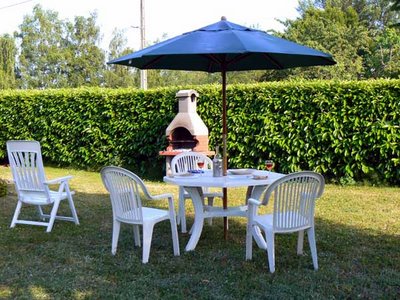 The stage is set (above) with the grill going and the table positioned in the shadow of a tree. It's about 7:00 pm; the sun doesn't set until nearly 10:00 pm, so there's lots of daylight left. Instead of charcoal, I've been burning the dead limbs that I've cut off our apple and plum trees in the yard. The fire burns hot and provides a great bed of embers for cooking.
The stage is set (above) with the grill going and the table positioned in the shadow of a tree. It's about 7:00 pm; the sun doesn't set until nearly 10:00 pm, so there's lots of daylight left. Instead of charcoal, I've been burning the dead limbs that I've cut off our apple and plum trees in the yard. The fire burns hot and provides a great bed of embers for cooking.
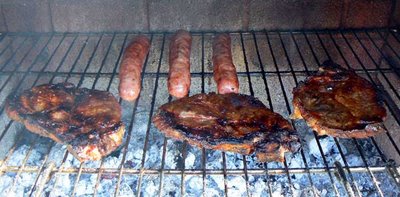 On the menu were marinated pork chops and duck sausages (cooking above) and a puréed zucchini thing (for lack of a better name) that was made by incorporating bread crumbs, cream, eggs and spices into the squash purée and cooking it until set.
On the menu were marinated pork chops and duck sausages (cooking above) and a puréed zucchini thing (for lack of a better name) that was made by incorporating bread crumbs, cream, eggs and spices into the squash purée and cooking it until set.
 The table is set and waiting for the meat to come off the grill! And here it is, the star of the show:
The table is set and waiting for the meat to come off the grill! And here it is, the star of the show:
 Dessert was an apple/blueberry tart that I made earlier in the day. And yes, the use of frozen blueberries from chez Picard totally contradicts yesterday's post about eating in season. Oh well, it's the exception that proves the rule, or some lame excuse like that.
Dessert was an apple/blueberry tart that I made earlier in the day. And yes, the use of frozen blueberries from chez Picard totally contradicts yesterday's post about eating in season. Oh well, it's the exception that proves the rule, or some lame excuse like that.
 In any case, it was delicious. All was served with local gamay red and rosé. Here's our houseguest, Sue, relaxing after dinner:
In any case, it was delicious. All was served with local gamay red and rosé. Here's our houseguest, Sue, relaxing after dinner:

 The stage is set (above) with the grill going and the table positioned in the shadow of a tree. It's about 7:00 pm; the sun doesn't set until nearly 10:00 pm, so there's lots of daylight left. Instead of charcoal, I've been burning the dead limbs that I've cut off our apple and plum trees in the yard. The fire burns hot and provides a great bed of embers for cooking.
The stage is set (above) with the grill going and the table positioned in the shadow of a tree. It's about 7:00 pm; the sun doesn't set until nearly 10:00 pm, so there's lots of daylight left. Instead of charcoal, I've been burning the dead limbs that I've cut off our apple and plum trees in the yard. The fire burns hot and provides a great bed of embers for cooking. On the menu were marinated pork chops and duck sausages (cooking above) and a puréed zucchini thing (for lack of a better name) that was made by incorporating bread crumbs, cream, eggs and spices into the squash purée and cooking it until set.
On the menu were marinated pork chops and duck sausages (cooking above) and a puréed zucchini thing (for lack of a better name) that was made by incorporating bread crumbs, cream, eggs and spices into the squash purée and cooking it until set. The table is set and waiting for the meat to come off the grill! And here it is, the star of the show:
The table is set and waiting for the meat to come off the grill! And here it is, the star of the show: Dessert was an apple/blueberry tart that I made earlier in the day. And yes, the use of frozen blueberries from chez Picard totally contradicts yesterday's post about eating in season. Oh well, it's the exception that proves the rule, or some lame excuse like that.
Dessert was an apple/blueberry tart that I made earlier in the day. And yes, the use of frozen blueberries from chez Picard totally contradicts yesterday's post about eating in season. Oh well, it's the exception that proves the rule, or some lame excuse like that. In any case, it was delicious. All was served with local gamay red and rosé. Here's our houseguest, Sue, relaxing after dinner:
In any case, it was delicious. All was served with local gamay red and rosé. Here's our houseguest, Sue, relaxing after dinner:
Labels:
food and cooking,
our house
Sunday, June 11, 2006
Eating Fruits and Vegetables
 Over at Chitlins’ and Camembert, Amy H. had a great post recently about vegetable seasons. I’m certain she knows more about eating in season than she lets on…
Over at Chitlins’ and Camembert, Amy H. had a great post recently about vegetable seasons. I’m certain she knows more about eating in season than she lets on…Having lived in the San Francisco Bay Area for nearly 20 years, Ken and I can certainly relate to Amy’s statement that in the US you can find nearly every kind of vegetable or fruit nearly any time of year, at least in the big cities, anyway. Tomatoes were always iffy, as Amy noted, even in season, and we could never get good corn-on-the-cob in San Francisco. What’s up with that?
The common theme we found with these year-round vegetables and fruits was cost. It’s expensive to import from Chile, Australia, and other worldwide locales. It’s also expensive to maintain greenhouses, and more and more of California’s prime agricultural land is giving way to housing developments and shopping malls and… ugh. This is one reason we left California.
There were, however, vegetables and fruits in California that were seasonal, and we came to know what they were. Artichokes, lettuces and strawberries from down near Monterey Bay in spring, cherries (even from San José), stone fruits (peaches, plums, nectarines) from the Central Valley orchards in July, grapes in summer, nuts in the fall, citrus and dates from the desert orchards in winter, and so much more.
When we moved to France a few years ago, we got even more educated about eating in season and now can’t imagine going back to the old ways.
What does it mean to eat in season? For us, it means eating fresh food produced by local farmers (and your own garden if you’re lucky) when it’s ready. This goes not only for fruit and vegetables, but also for some meats like lamb and veal. By paying attention to what we’re buying and when, we can really avoid a lot of expensive prepared foods and (not-so-tasty) imports by eating things when they’re ready. And we’ve come to anticipate the seasons for what we will be harvesting and eating much the way children get excited about an upcoming birthday or the winter holidays.
I should mention that some foods are imported in season, so it’s not necessarily the idea of importing that’s bad. Here in France, the winter holiday season is the time for clémentines from Spain and Morocco. They’re sweet and tasty, and they just shout Noël!
Around the Loire Valley, and more specifically in la Sologne, springtime is asparagus time. Big bunches of fat, white asparagus suddenly begin to appear in the local markets. The supermarkets try to get a jump on the locals by bringing early asparagus up from the Bordeaux area, but you pay for it. It’s fun to drive around and see your neighbors tending their asparagus rows, carefully building up the soil so as not to let the sun touch the tender white spears. We also see people out in the fields with that special asparagus tool that harvests the spears while they’re still underground. It’s a manual process all the way. Then you see the bundles appearing in the market, and each time you go, the prices drop as the supply increases. Thin spears, medium-sized spears, fat spears, and the prime tips are all on display and they disappear fast.
Anticipating asparagus season is fast becoming a ritual at our house. It means not only will we get to eat great fresh spears all kinds of ways, but that the days are lengthening and getting warmer. For the rest of my life, I will think of spring in the Loire Valley when I see or eat asparagus.
It’s funny; I never really liked asparagus until I moved here. Now, I can’t imagine not eating them. They’re great cooked until tender and served hot with butter, salt and pepper. Cold cooked spears are a treat with vinaigrette or home made mayonnaise. And my favorite recipe entails wrapping a few spears in a slice of ham, lining up about 6 of these wrapped bundles in a pan and covering it with béchamel sauce, gruyere cheese, then sliding the thing into the oven until it bubbles and the melting cheese browns a bit. Yum!
Then, one day, it’s over. Summer arrives and the asparagus get too pricey, then they’re gone altogether. It was great while it lasted, but they’ll be back again next year.
It’s not just the asparagus, though. Strawberries, artichokes, peppers, eggplant, tomatoes and so on, they all have their special seasons. We’re fortunate enough to have the land and the time for our own potager, or kitchen garden. This year is our third season for the garden and each year we learn a little more about what we’re doing, how much to plant, when to plant, etc.
We plant tomatoes, bell peppers, cayenne peppers, eggplant, beans, cucumbers, squash (both summer and winter varieties), greens (collard and mustard), and all manner of herbs. We have apple trees, and our neighbors have plum and quince trees, and we all share our harvests freely, at the appropriate time, of course. We even put in a fig tree that we hope will start producing fruit in a year or so.
As is the way with home gardens, there is usually much more produce than we and our neighbors can eat. This is where preservation comes in. The first year, we tried our hand at canning tomato sauce, which worked just fine, but it’s a lot of work. Last year, we got a freezer and have become freezer junkies! There’s practically nothing that can’t be prepped for the freezer and packed up in zip-top bags for good eating during the winter. We freeze tomatoes and tomato sauce (first in Tupperware, then we pop the frozen blocks out into zip-top bags so we get to re-use the container). We freeze red bell peppers, sometimes blanched, sometimes roasted. We slice zucchini into rounds, freeze them on cookie sheets, and slide them into the zip-top bags. We purée winter squash and pumpkins and we make applesauce, freeze each in usable-sized blocks and thaw them out for holiday pies and winter soups.
 Our first attempt at canning tomato sauce (2004), and our home-grown red bell peppers (on the left).
Our first attempt at canning tomato sauce (2004), and our home-grown red bell peppers (on the left).We’ve preserved cayenne peppers in vinegar with great success, and last year we had so many cucumbers that we made 13 quarts of pickles! And, they’re good. We have even prepped and frozen herbs like cilantro and basil that we can’t really find fresh locally during the winter.
I know, I’ve kind of gotten off the topic of eating in season. But when we’re eating our own home-grown produce, whether in season or in the dead of winter, we’re still enjoying seasonal products without paying the price of imported, out-of-season food. And that makes me smile. Thanks, Amy!
Labels:
food and cooking,
garden flowers plants
Saturday, June 10, 2006
Un Jour, Une Tour [14]
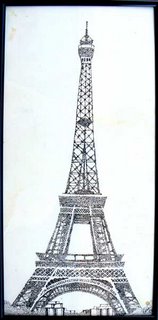 This tower was drawn for me by my friend Sue's son, Eric. He did it when he was 17 - he's now just about to turn 30 - and it's been hanging in our house ever since.
This tower was drawn for me by my friend Sue's son, Eric. He did it when he was 17 - he's now just about to turn 30 - and it's been hanging in our house ever since.He did it with an ink pen, making dots in all the right places until the image came out the way he wanted it. You might be able to see the dot detail in the close-up below.
It's one of my favorites in the tower series and it hangs very close to the rest of the collection.
Thanks, Eric!

Labels:
eiffel tower
Friday, June 09, 2006
Walking Along the Loire
 A little up-river from Blois is a town called Cour-sur-Loire. It's a very pretty place, perched on the river as it is, just up from the Château de Menars. There are walking trails along the river there, as I suspect there are pretty much everywhere, and we went for a great little Sunday hike recently. Here's some of what we saw:
A little up-river from Blois is a town called Cour-sur-Loire. It's a very pretty place, perched on the river as it is, just up from the Château de Menars. There are walking trails along the river there, as I suspect there are pretty much everywhere, and we went for a great little Sunday hike recently. Here's some of what we saw:
Labels:
loire valley
Thursday, June 08, 2006
Château de Valmer
The Château de Valmer is located over near Vouvray. It's a wine producing château that is also famous for its garden, most notably its vegetable garden that preserves historic varieties.
 One of the terraces at Valmer, with vine-covered hillside behind. The château itself burned down a while back, so there are only out-buildings left, and a good sized secondary home.
One of the terraces at Valmer, with vine-covered hillside behind. The château itself burned down a while back, so there are only out-buildings left, and a good sized secondary home.
We visited Valmer one day in May and strolled around for a while, envious of the resources and talent that these gardeners have.
 Now this is what I call a vegetabel garden! This is just the centerpiece, of course, with plots and trellises and coldframes all around.
Now this is what I call a vegetabel garden! This is just the centerpiece, of course, with plots and trellises and coldframes all around.
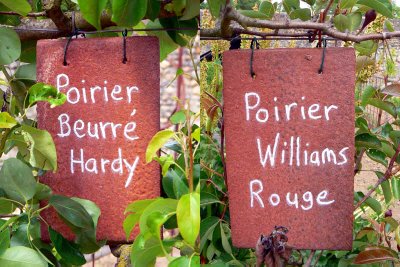 The gardeners used terra cotta roof tiles as signs. These are two varieties of pears that were espaliered along a south-facing wall.
The gardeners used terra cotta roof tiles as signs. These are two varieties of pears that were espaliered along a south-facing wall.
 Most of the vegetables and herbs were just getting started, of course. I'd love to go back toward the end of July and see what the produce is like! We also tasted some of their wine since the tasting was included in the price of admission. The sparkling was quite good, and we bought a few bottles which quickly disappeared around dinner time.
Most of the vegetables and herbs were just getting started, of course. I'd love to go back toward the end of July and see what the produce is like! We also tasted some of their wine since the tasting was included in the price of admission. The sparkling was quite good, and we bought a few bottles which quickly disappeared around dinner time.
 One of the terraces at Valmer, with vine-covered hillside behind. The château itself burned down a while back, so there are only out-buildings left, and a good sized secondary home.
One of the terraces at Valmer, with vine-covered hillside behind. The château itself burned down a while back, so there are only out-buildings left, and a good sized secondary home.We visited Valmer one day in May and strolled around for a while, envious of the resources and talent that these gardeners have.
 Now this is what I call a vegetabel garden! This is just the centerpiece, of course, with plots and trellises and coldframes all around.
Now this is what I call a vegetabel garden! This is just the centerpiece, of course, with plots and trellises and coldframes all around. The gardeners used terra cotta roof tiles as signs. These are two varieties of pears that were espaliered along a south-facing wall.
The gardeners used terra cotta roof tiles as signs. These are two varieties of pears that were espaliered along a south-facing wall. Most of the vegetables and herbs were just getting started, of course. I'd love to go back toward the end of July and see what the produce is like! We also tasted some of their wine since the tasting was included in the price of admission. The sparkling was quite good, and we bought a few bottles which quickly disappeared around dinner time.
Most of the vegetables and herbs were just getting started, of course. I'd love to go back toward the end of July and see what the produce is like! We also tasted some of their wine since the tasting was included in the price of admission. The sparkling was quite good, and we bought a few bottles which quickly disappeared around dinner time.
Labels:
châteaux,
loire valley
Subscribe to:
Posts (Atom)

